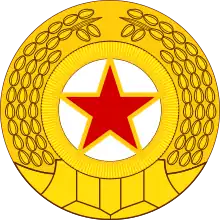Kim Kwang-hyop
Kim Kwang-hyop (Korean: 김광협, 1915 – 1970) was an anti-Japanese activist and a military officer and politician of the Democratic People's Republic of Korea (commonly, North Korea). He served as Chief of the General Staff of the Korean People's Army.[1]
Kim Kwang-hyop | |
|---|---|
| Chief of the General Staff of the Korean People's Army | |
| In office August 1953 – September 1957 | |
| Minister of People's Armed Forces | |
| In office September 1957 – 1962 | |
| Personal details | |
| Born | 1915 Hoeryong, North Hamgyong Province, North Korea |
| Died | 1970 (aged 54–55) |
| Nationality | Korean |
| Political party | Workers' Party of Korea |
| Military service | |
| Battles/wars | See battles
|

Biography
He was born in Hoeryong, North Hamgyong Province, in 1915. In 1930, at the age of 16, he moved to China and graduated from Huangpu Military Academy, where he worked as an anti-Japanese partisan. In 1935, he joined the Chinese Communist Party, and in 1940 he served as the second member of the Northeast Anti-Japanese United Army's Second Army. After the fall of the Japanese Empire, he became the commander of the military district of the Northeast Democratic Army of the pro-Soviet Provisional People's Committee of North Korea.
At the onset of the Korean War he was the commander of the Second Army of the Korean People's Army.[2] After the armistice of the Korean War, he was promoted to the Chief of the General Staff of the Korean People's Army. He served as a delegate to the Supreme People's Assembly in following the 1957 North Korean parliamentary election and from September that year until October 1962 he was also Minister of People's Armed Forces.
References
- Communism in Korea: The society, p. 935
- North Korea: How Did It Prepare for the 1950 Attack? in Army History No. 49 (Spring 2000), pp. 1-15
